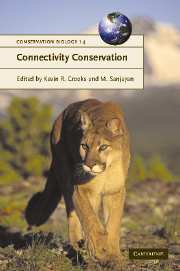Book contents
- Frontmatter
- Contents
- List of contributors
- Acknowledgements
- 1 Connectivity conservation: maintaining connections for nature
- PART I Approaches to connectivity research
- PART II Assessing connectivity
- Introduction: evaluating and quantifying the conservation dividends of connectivity
- 12 Quantifying connectivity: balancing metric performance with data requirements
- 13 Assessing connectivity in salmonid fishes with DNA microsatellite markers
- 14 Individual-based modeling as a tool for conserving connectivity
- 15 Linking connectivity to viability: insights from spatially explicit population models of large carnivores
- 16 Impacts of corridors on populations and communities
- 17 Exploring the functional connectivity of landscapes using landscape networks
- PART III Challenges and implementation of connectivity conservation
- Index
- References
17 - Exploring the functional connectivity of landscapes using landscape networks
Published online by Cambridge University Press: 24 May 2010
- Frontmatter
- Contents
- List of contributors
- Acknowledgements
- 1 Connectivity conservation: maintaining connections for nature
- PART I Approaches to connectivity research
- PART II Assessing connectivity
- Introduction: evaluating and quantifying the conservation dividends of connectivity
- 12 Quantifying connectivity: balancing metric performance with data requirements
- 13 Assessing connectivity in salmonid fishes with DNA microsatellite markers
- 14 Individual-based modeling as a tool for conserving connectivity
- 15 Linking connectivity to viability: insights from spatially explicit population models of large carnivores
- 16 Impacts of corridors on populations and communities
- 17 Exploring the functional connectivity of landscapes using landscape networks
- PART III Challenges and implementation of connectivity conservation
- Index
- References
Summary
INTRODUCTION
Understanding landscape connectivity is an important research challenge for conservation science (Taylor et al. 1993). A relatively recent development in pursuit of this challenge is the differentiation between functional and structural connectivity of landscapes. Structural connectivity is based on the spatial arrangement of different types of habitat in a landscape, while functional connectivity recognizes the behavioral response of individuals, species, or ecological processes to the physical structure of the landscape (Baudry and Merriam 1988; Bennett 1999; Crooks and Sanjayan Chapter 1; Taylor et al. Chapter 2; Fagan and Calabrese Chapter 12). A number of conceptual and practical developments have contributed to the recognition of and ability to conduct analyses of functional landscape connectivity.
The patch–matrix–corridor conceptualization of landscapes (Forman and Godron 1986) that built on the theory of island biogeography (MacArthur and Wilson 1967) has strongly influenced work on landscape connectivity. Many researchers have recognized that island biogeography's assumption of islands of habitat distributed throughout a homogenous matrix of non-habitat (i.e., the so-called “inhospitable sea”) is overly simple and does not recognize an organism-centric perspective of the landscape that differentiates perception, mobility, and resource use by individuals and species (Johnson et al. 1992; Wiens 1994). For example, Vos and Stumpel (1995) examined the relationship between pond occupancy by tree frogs and distance to the nearest occupied pond, but the heterogeneity of the intervening landscape was ignored.
- Type
- Chapter
- Information
- Connectivity Conservation , pp. 416 - 444Publisher: Cambridge University PressPrint publication year: 2006
References
- 48
- Cited by



